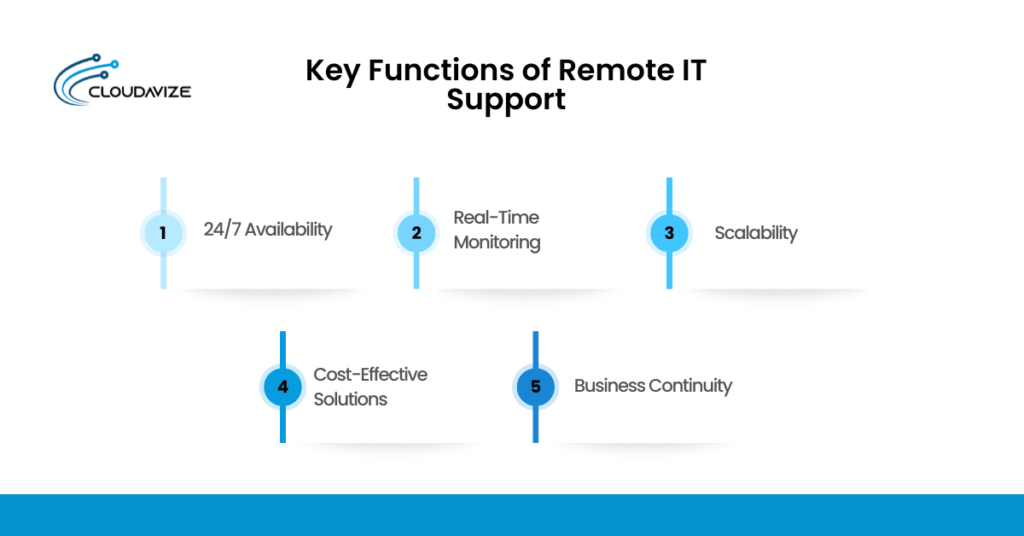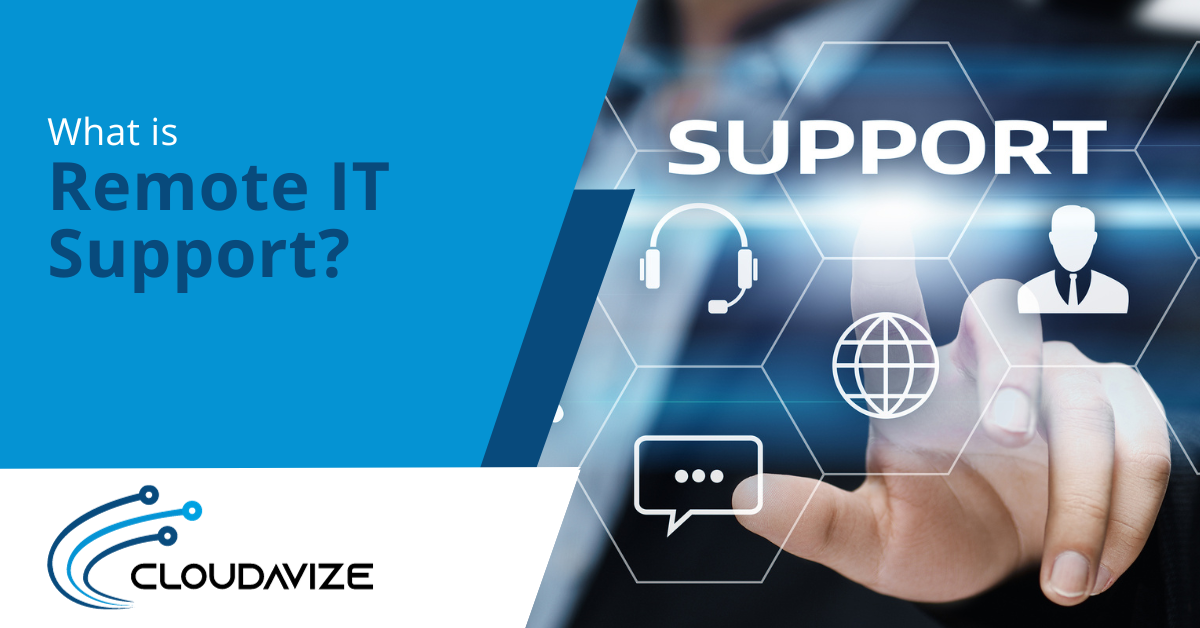Remote IT support is a professional service where IT technicians resolve issues, maintain systems, and secure networks from a remote location. Using secure access tools like encrypted remote desktop software and secure connection protocols, businesses can troubleshoot problems, apply updates, and monitor systems without waiting for on-site visits, which keeps operations running smoothly.
This support is generally offered in two ways. Attended remote support connects a technician with the user in real time for urgent troubleshooting or guided problem-solving, while unattended remote support runs in the background, allowing updates, monitoring, and routine maintenance without user involvement. Together, these approaches cover both immediate issues and long-term system care.
The approach improves productivity, reduces costs, and supports business continuity. While challenges like communication barriers, internet instability, and limited access to hardware exist, the key functions, including 24/7 availability, proactive monitoring, scalability, and cost-effectiveness, make remote IT support essential for modern businesses.
Table of Contents
Types of Remote IT Support
Remote IT support is offered in two main forms, attended and unattended, each designed for different scenarios. Attended support connects a technician and user in real time for quick troubleshooting, while unattended support lets technicians perform updates and maintenance without user involvement. Using both approaches ensures businesses can respond immediately to critical issues while keeping systems reliable through ongoing care.
Attended Remote Support
When a business faces an urgent IT problem that disrupts daily work, the attended remote support provides immediate relief by restoring productivity without waiting for on-site assistance. In this model, a technician connects directly to the user’s device and communicates in real time, making it ideal for issues that require step-by-step guidance. Common scenarios include password resets, email configuration problems, or sudden software crashes during client meetings. This hands-on interaction not only speeds up troubleshooting but also helps users learn how to handle similar problems in the future. For companies that rely on uninterrupted workflows, attended remote support ensures downtime is minimized and customer-facing operations continue smoothly.
Unattended Remote Support
Businesses that want consistent reliability and stronger security benefit from unattended remote support, where technicians can access company systems and perform work without the user being present. This approach is commonly used for installing operating system patches, applying antivirus updates, monitoring server performance, and running scheduled backups across multiple devices. Because these tasks can be performed after hours, employees avoid interruptions and continue working without delays during the day. For organizations with distributed teams or limited in-house IT staff, unattended remote support provides a cost-effective way to ensure systems remain secure, fully updated, and capable of supporting long-term business growth.
How Remote IT Support Benefits Businesses?
Remote IT support improves productivity, reduces downtime, and lowers costs by resolving issues quickly without on-site visits. It also supports business continuity with 24/7 monitoring and gives remote teams reliable access to technical help, making it a flexible and cost-effective solution for modern businesses.

Increased Productivity
When IT issues such as email outages, software crashes, or network slowdowns are resolved remotely within minutes, employees avoid losing valuable work time. Remote IT support eliminates the wait for on-site visits by allowing technicians to log in securely, diagnose problems, and restore systems almost immediately. Continuous monitoring also helps prevent downtime by detecting early warning signs like storage overloads or security threats. By keeping operations stable and employees focused on core tasks, remote IT support directly increases output and helps businesses maintain consistent performance.
Quick Response Times
Delays in fixing IT problems can bring entire workflows to a halt, which is why remote IT support focuses on rapid response. By connecting through secure remote desktop tools, technicians can resolve common issues such as failed software updates, frozen applications, or malfunctioning printers within minutes. This speed prevents small errors from turning into full system outages and helps employees avoid hours of lost productivity. For businesses that rely on time-sensitive tasks like client communications or transaction processing, quick response times ensure operations continue smoothly and deadlines are met.
Improved Customer Service
Reliable IT systems are critical to customer interactions, and remote support ensures issues are resolved quickly before they affect service quality. For example, sales teams can continue processing transactions if payment terminals malfunction, and support staff can keep assisting clients even if their CRM freezes. By restoring tools like email, chat platforms, or VoIP phones in real time, technicians minimize disruptions that could frustrate customers. This consistency not only improves day-to-day experiences but also builds lasting loyalty and strengthens the company’s reputation.
Lower Operational Costs
Remote IT support significantly lowers operational expenses by reducing the need for frequent on-site visits and the associated travel, labor, and downtime costs. IT technicians can perform tasks such as deploying software, applying security patches, or diagnosing network failures remotely, often in less time than traditional service calls. Businesses also save on staffing by relying less on full-time in-house IT teams while still receiving expert coverage. These cost efficiencies free up capital for critical priorities like cybersecurity upgrades, cloud adoption, or employee productivity tools.
Enhanced Business Continuity
Unexpected IT failures can halt operations, but remote IT support ensures business continuity by keeping critical systems running with minimal disruption. Technicians can immediately respond to problems such as database errors, email outages, or network instability, restoring services before they affect staff or customers. Since support is available 24/7, businesses can rely on constant uptime, even during evenings or weekends. This timely response is especially valuable for industries like finance, healthcare, and retail, where uninterrupted access to IT systems is essential for daily operations.
Flexibility for Remote Teams
As more businesses operate with remote or hybrid workforces, having consistent IT support across locations has become essential for maintaining productivity. With secure remote desktop tools and cloud-based monitoring, technicians can resolve problems such as software access errors, VPN connectivity failures, or device configuration issues for employees working from home, branch offices, or on the road. This consistency ensures that every team member receives the same level of support regardless of location. By adapting quickly to remote demands, companies can scale confidently and keep operations seamless.
Challenges of Remote IT Support
While remote IT support offers speed and efficiency, businesses often face challenges such as communication barriers, poor connectivity, and limitations in fixing hardware issues. These obstacles can delay troubleshooting or require on-site help, making it important for companies to strengthen communication, invest in reliable networks, and prepare for hardware support when needed.
Communication Barriers
One of the common challenges in remote IT support is the lack of direct interaction, which can affect how quickly and accurately problems are resolved. When technicians rely on technical jargon or when employees lack IT knowledge, instructions can be misunderstood, leading to wasted time and frustration. Communication gaps are amplified when only basic tools like email or chat are used without visual context. Businesses can reduce these risks by using structured communication methods such as video calls, screen sharing, and step-by-step guidance that improve clarity and speed.
Connectivity Issues
Smooth remote IT support depends on a reliable internet connection, yet many businesses still struggle with unstable networks that disrupt service. Poor bandwidth, frequent outages, or dropped VPN sessions can prevent technicians from completing updates, troubleshooting effectively, or even maintaining a live connection. When this happens, small issues may remain unresolved and escalate into bigger problems. To avoid these risks, businesses must invest in strong internet infrastructure, backup connections, and network monitoring tools that ensure remote support remains dependable and timely.
Technical Limitations
While remote IT support streamlines many processes and reduces downtime, it cannot fully replace the need for on-site assistance when hardware problems occur. Tasks such as replacing a failing hard drive, repairing a server’s power supply, or reconnecting a damaged cable require physical intervention that remote tools cannot provide. These gaps can extend resolution times and disrupt business operations if on-site support is not available. To maintain reliability, companies must combine remote services with local technicians who can step in for hardware-related issues.
User Dependency and Technical Skills
The effectiveness of remote IT support often depends on the technical skills of the employees receiving help. Users with limited knowledge may struggle to follow troubleshooting steps, such as configuring network settings, installing updates, or running diagnostic tools, which can slow down resolutions or lead to miscommunication. Technicians must provide clear, simplified instructions and use user-friendly tools like guided screen sharing to bridge this gap. Building basic IT proficiency among staff not only speeds up support but also reduces recurring issues that strain business productivity.
Limited Access to Physical Hardware
Remote IT support is highly effective for resolving software issues, but it cannot address problems that require direct access to physical equipment. Tasks like replacing faulty hard drives, repairing server hardware, or fixing damaged network cables cannot be completed remotely, which can delay resolutions and disrupt operations. These limitations make it important for businesses to maintain a balance between remote support and on-site assistance. Having access to local technicians ensures that critical hardware repairs are handled quickly, minimizing downtime and protecting productivity.
Key Functions of Remote IT Support
The key functions of remote IT support are 24/7 availability, real-time monitoring, scalability, and cost-effectiveness. Continuous access ensures issues are resolved anytime, proactive monitoring prevents problems from escalating, scalability supports business growth, and reduced on-site visits lower costs. These features make remote IT support a reliable and efficient solution for modern businesses.

24/7 Availability
Businesses today cannot afford downtime, which is why 24/7 availability in remote IT support is so important. With technicians on call at all hours, problems such as server failures, network disruptions, or system crashes can be addressed immediately, no matter when they occur. This constant access is particularly valuable for companies with global operations, remote teams, or critical processes that run outside regular business hours. By ensuring uninterrupted coverage, 24/7 support maintains business continuity and provides peace of mind for employees and clients alike.
Real-Time Monitoring
Preventing problems before they affect operations is one of the biggest advantages of real-time monitoring in remote IT support. By continuously tracking servers, applications, and networks, technicians can quickly identify warning signs such as unusual traffic spikes, failing updates, or storage overloads. Acting on these alerts reduces downtime, prevents major system failures, and keeps performance steady. With proactive monitoring in place, businesses gain the confidence that potential vulnerabilities are addressed immediately, keeping IT systems reliable and business operations uninterrupted.
Scalability
For growing businesses, scalability in remote IT support provides the flexibility to expand without adding unnecessary costs or complexity. As new employees are hired, additional devices are deployed, or new offices opened, IT services can scale seamlessly to match demand. This adaptability ensures systems remain reliable and well-supported at every stage of growth. By paying only for the resources they need, companies achieve cost-efficient expansion while avoiding expensive infrastructure upgrades or large in-house IT teams.
Cost-Effective Solutions
One of the most important functions of remote IT support is providing cost-effective solutions that reduce expenses without compromising reliability. By eliminating the need for a full in-house IT team and cutting down on on-site service visits, businesses save significantly on staffing and travel costs. Remote technicians deliver expert support on demand, while predictable, scalable pricing models make budgeting easier. This function not only creates immediate savings but also ensures long-term financial stability by avoiding large infrastructure investments and keeping IT management efficient.
Business Continuity
As one of the key functions of remote IT support, business continuity focuses on keeping systems operational and minimizing downtime. By continuously monitoring networks and responding quickly to problems such as server crashes, cyber threats, or failed updates, technicians ensure that critical services remain available. This proactive approach helps companies avoid major disruptions and maintain smooth operations. For industries that rely heavily on IT infrastructure, like finance, healthcare, and retail, remote IT support provides the resilience needed to protect revenue, customer trust, and long-term stability.
Choosing the Right Remote IT Support Provider
Choosing the right managed service provider (MSP) is critical to ensuring businesses receive reliable, scalable, and cost-effective remote IT support. The right service provider can tailor services to fit specific needs, whether that means supporting a small team, securing sensitive client data, or managing multi-site operations. Beyond affordability, businesses should look for 24/7 monitoring, proactive problem resolution, and scalable plans that adapt as the company grows. By partnering with the right MSP, organizations gain consistent, high-quality support that protects systems and strengthens long-term growth.
For businesses seeking reliable remote IT support services, contact Cloud Avize. We are dedicated to providing cutting-edge solutions tailored to your specific needs.



